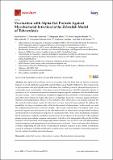Por favor, use este identificador para citar o enlazar a este item:
http://hdl.handle.net/10261/221692COMPARTIR / EXPORTAR:
 SHARE SHARE
 CORE
BASE CORE
BASE
|
|
| Visualizar otros formatos: MARC | Dublin Core | RDF | ORE | MODS | METS | DIDL | DATACITE | |

| Título: | Vaccination with alpha-Gal protects against mycobacterial infection in the zebrafish model of tuberculosis |
Autor: | Pacheco, Iván CSIC; Contreras, Marinela CSIC ORCID; Villar, Margarita CSIC ORCID; Risalde, María Ángeles CSIC ORCID; Alberdi, Pilar CSIC ORCID; Cabezas-Cruz, Alejandro CSIC ORCID; Gortázar, Christian CSIC ORCID ; Fuente, José de la CSIC ORCID | Palabras clave: | Alpha-gal Vaccine Mycobacterium Immunology |
Fecha de publicación: | 2020 | Editor: | Multidisciplinary Digital Publishing Institute | Citación: | Vaccines 8(2): 195 (2020) | Resumen: | The alpha-Gal syndrome (AGS) is associated with tick bites that can induce in humans high levels of IgE antibodies against the carbohydrate Galα1-3Galβ1-(3)4GlcNAc-R (α-Gal) present in glycoproteins and glycolipids from tick saliva that mediate primarily delayed anaphylaxis to mammalian meat consumption. It has been proposed that humans evolved by losing the capacity to synthesize α-Gal to increase the protective immune response against pathogens with this modification on their surface. This evolutionary adaptation suggested the possibility of developing vaccines and other interventions to induce the anti-α-Gal IgM/IgG protective response against pathogen infection and multiplication. However, the protective effect of the anti-α-Gal immune response for the control of tuberculosis caused by Mycobacterium spp. has not been explored. To address the possibility of using vaccination with α-Gal for the control of tuberculosis, in this study, we used the zebrafish-Mycobacterium marinum model. The results showed that vaccination with α-Gal protected against mycobacteriosis in the zebrafish model of tuberculosis and provided evidence on the protective mechanisms in response to vaccination with α-Gal. These mechanisms included B-cell maturation, antibody-mediated opsonization of mycobacteria, Fc-receptor (FcR)-mediated phagocytosis, macrophage response, interference with the α-Gal antagonistic effect of the toll-like receptor 2 (TLR2)/nuclear factor kappa-light-chain-enhancer of activated B cells (NF-kB)-mediated immune response, and upregulation of pro-inflammatory cytokines. These results provided additional evidence supporting the role of the α-Gal-induced immune response in the control of infections caused by pathogens with this modification on their surface and the possibility of using this approach for the control of multiple infectious diseases. | Versión del editor: | https://doi.org/10.3390/vaccines8020195 | URI: | http://hdl.handle.net/10261/221692 | DOI: | 10.3390/vaccines8020195 | E-ISSN: | 2076-393X |
| Aparece en las colecciones: | (IREC) Artículos |
Ficheros en este ítem:
| Fichero | Descripción | Tamaño | Formato | |
|---|---|---|---|---|
| vaccintuber.pdf | 6,22 MB | Adobe PDF |  Visualizar/Abrir |
CORE Recommender
PubMed Central
Citations
18
checked on 18-abr-2024
SCOPUSTM
Citations
27
checked on 15-abr-2024
WEB OF SCIENCETM
Citations
24
checked on 29-feb-2024
Page view(s)
118
checked on 17-abr-2024
Download(s)
133
checked on 17-abr-2024

